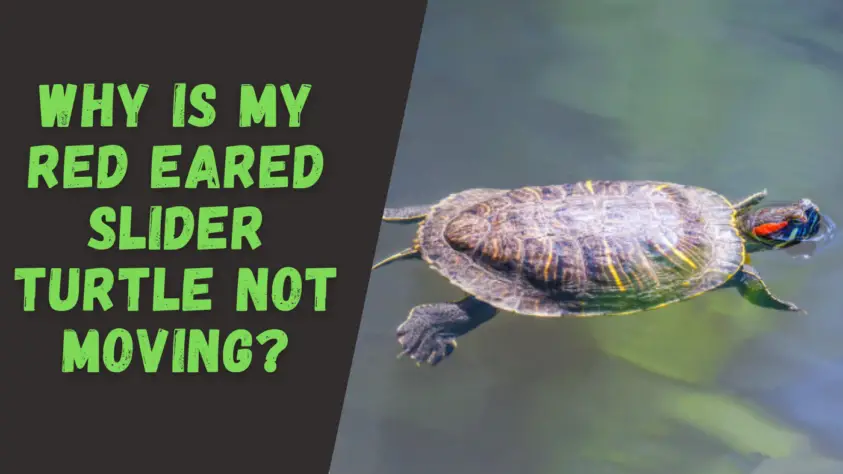Owning a red eared slider can be pretty tricky sometimes. From creating the perfect habitat to figuring out the best diet, a lot of research is needed. It can also be stressful if you notice any changes in behavior. Your mind might race immediately to the worst case scenarios.
One thing that some red eared slider owners may face at some point is the concern that their turtle is not moving. You probably want to know what causes this to happen. You also probably want to know how to encourage your turtle to move.
There are a few different reasons that a red eared slider would stop moving, some being more severe than others. And yes, there are plenty of ways to prevent this behavior from occurring. So what exactly are the reasons why a red eared slider stops moving?
Why is My Red Eared Slider Turtle Not Moving?
The main reasons your red eared slider is not moving is because they ate too much food, they are sick, they are brumating, or they are dying.
Too much food!
The main reason your red eared slider is not moving is because he is being overfed. Yes, you can over feed a turtle! Remember that younger and smaller turtles need to eat once a day, but as they get older red eared sliders only need to eat every 2-3 days.
Turtles are opportunistic eaters, which means they will continue to eat anything that is put in front of them. While it can be tempting, you should never feed your turtle more than 1 or 2 times in a day.
Even if your turtle is begging by sticking their head out of the water, you shouldn’t give in as it can have negative health effects.
Illness
Noticing that your red eared slider isn’t moving can be pretty frightening. No one wants to think that there could be something wrong with their pet, but sometimes turtles will develop illnesses.
One reason that your red eared slider may have stopped moving is because he is starting to get sick. There are other symptoms along with lethargy that can be signs for illness in red eared sliders. These include lack of appetite, squinty eyes, head twitching, and bubbles around the nose and mouth area. A turtle that is not moving might be suffering form a respiratory infection.
If you notice any of these symptoms it is important to call your vet and set up an appointment. In the meantime, you can check on your red eared slider’s habitat to make sure that everything is clean. You should also make sure the water is at the correct temperature, and that your turtle has access to a warm basking spot.
Brumation
If you notice that your red eared slider is starting to become less and less active, your turtle may be going into a state similar to hibernation called brumation. While pet red eared sliders do not typically brumate, they might enter the state if temperatures drop to a low level.
Red eared slider turtles are cold-blooded animals, meaning they can’t maintain their body temperature without the help of outside forces. That being said, the water that makes up the majority of a red eared slider’s habitat needs to be within 75 and 85 degrees Fahrenheit. If the water that your turtle lives in starts to dip too low, it could cause your turtle to become inactive.
Cold water can also lead to respiratory issues with your red eared slider. Therefore, it is important to have a thermometer in your tank in order to track the temperature.
Death
Nobody wants to think about their pet passing away, but sadly that is something that you can’t avoid when owning a pet animal. If your red eared slider has stopped moving for awhile, there is a possibility that your turtle has passed away.
If you think this is the cause, call your vet to set up an appointment at your turtle could just be deep in brumation. While you are waiting for you appointment try to encourage movement with a warm environment, some gently poking, and food.
If your turtle did die, you should read my article on why did my red eared slider die suddenly?
How can you keep your turtle healthy and moving?
Having a pet red eared slider stop moving sounds like a scary situation, and it is! It is the last thing that you are going to want happen if you own one. Now you might be wondering how you can keep your turtle moving.
Well, you have to keep your turtle healthy and happy! I know, easier said than done. But the first step to keeping a happy and healthy red eared slider is to focus on the habitat you keep them in. Ask yourself these questions:
Is the habitat big enough for my red eared slider? Do I have a way to keep the water warm enough? How am I going to test the temperature of the water?
How do I know if the water levels are right for my red eared slider? Do I have a warm basking spot for my turtle?
How am I going to make sure the temperature of the basking spot is right? Do I have my red eared slider turtle on a good feeding schedule?
You should ask all of these questions at the pet store when you buy your turtle and the supplies for their tank. If you have a red eared slider or are thinking about owning one in the future, it is just as important to have a good relationship with a vet for your turtle as it is for a cat or a dog.
Remember that accidents, like a red eared slider not moving, can happen no matter how hard you try to give the best care.

